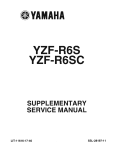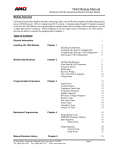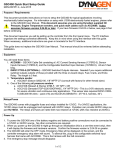Download VA-700 User Manual (Revision 09)
Transcript
VA-700 Analogue Video Distribution Amplifier User Manual IRT Electronics Pty Ltd | www.irtelectronics.com Revision 09 VA-700 ANALOGUE VIDEO DISTRIBUTION AMPLIFIER Revision History: Revision 01 02 03 Date 21/03/1996 02/07/1996 25/07/1996 By AJP AJP AJP 04 05 27/11/1996 12/01/2001 AJP AL 06 07 05/07/2002 11/09/2002 AL AL 08 22/10/2010 AL 09 22/05/2012 AL Change Description Original Issue. AVD-3120 sub-document included. Front & rear panels redrawn to scale with handle omitted. CVA-3120 sub-document included. IRT Border page added for PDF format, 00COMMON.doc file contents added Link paths reset Drawing list updated and all relevant test procedures (hidden) added. Obsolescence of sub-board information noted, test procedures (hidden) removed. Reformatted layout. Applicable to: S/N ≥ 9500000 S/N ≥ 9500000 S/N ≥ 9500000 S/N ≥ 9500000 S/N ≥ 9500000 S/N ≥ 9500000 S/N ≥ 9500000 S/N ≥ 9500000 S/N ≥ 9500000 IRT Electronics Pty Ltd | www.irtelectronics.com Page 2 of 23 Revision 09 VA-700 USER MANUAL Table of Contents: Section Page Revision History 2 Operational Safety 4 General Description 5 Technical Specifications 6 Configuration 7 Location of links & user settings 8 Installation 9 Front and rear layouts 10 Sub-modules (NOTE: Obsolete – No Longer Available. Information for existing modules only)11 DL-700 Delay & filter sub-module 11 General Description 11 Technical Specifications 12 Configuration 13 Installation 13 AVD-3120 Video sync failure detector 14 General Description 14 Technical Specifications 15 Configuration 16 Installation 16 CVA-3120 Remote gain control 17 General Description 17 Technical Specifications 18 Configuration 19 Installation 20 EQ-1227 Equaliser sub-board 21 General Description 21 Technical Specifications 21 Installation 22 Maintenance & Storage 23 Warranty & Service 23 Equipment return 23 This instruction book applies to Serial Numbers ≥ 9500000. IRT Electronics Pty Ltd | www.irtelectronics.com Page 3 of 23 Revision 09 VA-700 OPERATIONAL SAFETY WARNING Operation of electronic equipment involves the use of voltages and currents that may be dangerous to human life. Note that under certain conditions dangerous potentials may exist in some circuits when power controls are in the OFF position. Maintenance personnel should observe all safety regulations. Do not make any adjustments inside equipment with power ON unless proper precautions are observed. All internal adjustments should only be made by suitably qualified personnel. All operational adjustments are available externally without the need for removing covers or use of extender cards. IRT Electronics Pty Ltd | www.irtelectronics.com Page 4 of 23 Revision 09 VA-700 GENERAL DESCRIPTION BLOCK DIAGRAM VA-700 SIGNAL PATH ANALOGUE VIDEO I/P CABLE EQUALISATION & HUM REJECTION VDA + DC OFFSET CLAMPING CCT O/P 1 O/P 2 O/P 3 O/P 4 O/P 5 O/P 6 O/P 7 O/P 8 O/P 9 O/P 10 MON O/P The VA-700 is a video distribution amplifier of modular Eurocard construction having facilities for cable equalisation, longitudinal hum reduction, and clamping. The input is a bridging loop through type to facilitate connection to other equipment. Ten 75 Ω outputs are provided on the rear with an additional output on the front panel for ease of monitoring. The input and output grounds are separated to provide rejection of longitudinally developed hum. The input is AC coupled and the output DC restored with options for no clamping or clamping to the internal or an external signal. The external clamping facility may be used to provide correct DC restoration in YUV & RGB signal situations. The video gain may be varied by ± 3 dB from the front panel. Internal preset controls allow adjustment of the amplifier frequency response, optimisation of the longitudinal hum rejection, and stage output DC voltages. Cable equalisation is provided for up to 300 metres of 75 Ω high quality cable with adjustment via the front panel. The VA-700 may also be used as a pulse distribution amplifier. (Only 6 outputs may be used for 4 Vp-p) The VA-700 is manufactured on an extended Eurocard board for mounting in IRT Eurocard frames. Standard features: • • • • • • • • • IRT Eurocard construction Loop through input Ten BNC outputs on rear >30 MHz bandwidth Front panel monitoring output Cable equalisation to 300 metres Various clamping options Longitudinal hum stripping Front panel EQ & gain adjustment IRT Electronics Pty Ltd | www.irtelectronics.com Page 5 of 23 Revision 09 VA-700 TECHNICAL SPECIFICATIONS Input: Type Number Impedance Return loss Hum rejection Maximum level Differential AC coupled. 2. Looping. > 46 dB to 6 MHz. > 40 dB. > 2 Vp-p (0 dB gain). Outputs: Type Number Impedance Return loss Overload DC coupled. 11 (Ten on rear and one on front panel). 75 Ω source terminated. > 40 dB to 6 MHz. 3.0 Vp-p on 4.43 MHz sine wave; 2.5 Vp-p on pulse. Adjustable to 0 V. DC level Performance: Gain Frequency response Differential gain Differential phase Noise Cross talk Transit time Cable Equalisation ± 3 dB. Adjustable from front panel. ± 0.1 dB from 20 Hz to 20 MHz; ± 0.2 dB from 20 Hz to 30 MHz. < 0.1% at 4.43 MHz (12.5% - 87.5% APL). < 0.1° at 4.43 MHz (12.5% - 87.5% APL). < -70 dB (unweighted). < -75 dB (between modules). < 22° at 4.43 MHz. Up to 300 m, for Beldin YR23769 cable. Power requirement: Voltage Power consumption 28 Vac CT (14-0-14) or ±16 Vdc. < 3.5VA (all outputs loaded in 75 Ω). Other: Temperature Mechanical Finish Dimensions Front panel Rear assembly 0 - 50°C ambient. Suitable for mounting in IRT 19" rack chassis with input, output and power connections on the rear panel. Grey background, black lettering & red IRT logo. Detachable silk-screened PCB with direct mount connectors to Eurocard and external signals. 6 HP x 3 U x 220 mm IRT Eurocard. Due to our policy of continuing development, these specifications are subject to change without notice. IRT Electronics Pty Ltd | www.irtelectronics.com Page 6 of 23 Revision 09 VA-700 CONFIGURATION The VA-700 may be configured for several modes of operation. This is achieved by various link settings as outlined below. The VA-700 is normally delivered set for internal clamp operation and no sub-modules fitted. 1. No sub-module LK 2 - LK 3 soldered on board. LK 6 - LK 7 soldered on board. 2. Sub-module: See instructions for each module (Obsolete – no longer available. Reference for previous modules sold already in existence). Cable compensation: Circuitry provides compensation for up to 300 metres of Beldin YR23769 cable, links 8a and 8b are used to provide ranging of the compensation. A short on link 8a will allow for cable lengths of 75 m - 300 m to be compensated. Moving the link to position 8b will allow for cable lengths of 0 - 75 m to be compensated. Clamping option: Decide if the clamp feature of the VA-700 is required. In general the clamp feature is useful if the video signal is always composite. If you are using the VA-700 to distribute pulses or sub-carrier the clamp feature should be disabled (LK 1 installed), otherwise LK 1 should be removed. External clamp reference: An external video signal can be used to provide the reference for the clamp pulse generator circuit in the VA-700. The signal path from outputs 9 and/or 10 can be wired to the input of the clamp reference buffer amplifier. On the VDA remove the link between LK 10 - LK 12, and complete links LK 12 - LK 13, LK 14 - LK 15 and LK 16 - LK 17. Remove R 70 and R 71 connect a wire link between the rear pads of the R 70 position, the R 71 position and the rear pad of the unused R 80 position. The external clamp reference can now be looped through from the connector 9 and 10 positions on the rear assembly. Alternately: A terminated input for the external clamp reference can be provided by using only the output 10 connector position. On the VDA remove the link between LK 10 - LK 12, and complete links LK 12 - LK 13, LK 14 - LK 15 and LK 16 - LK 17. Remove R 71 and insert in the R 80 position. Now wire the end pads of R 80 and the R 71 position together. This will give a terminated input for the external clamp reference from output connector 10 on the rear assembly. IRT Electronics Pty Ltd | www.irtelectronics.com Page 7 of 23 Revision 09 VA-700 RGB video distribution: When operating three VDA's in a group for RGB signal distribution only the green signal will carry sync information. The video signal from the input amplifier of the GREEN signal VDA can be sourced to the other VDA's by rewiring links on the 'plug-in area' of the VDA's. By rewiring the signal path to VDA outputs 9 and 10 these connectors can be used to carry the GREEN video signal to the RED and BLUE VDA's clamp pulse generator circuitry. On the GREEN VDA complete links LK 11 - LK 13, LK 14 - LK 15 and LK 16- LK 17. Remove R 71 and connect a wire link between the rear pad of the R 71 position and the rear pad of the unused R 80 position. This will source the video to output connector 10 on the rear assembly. On the RED and BLUE VDA's remove the link between LK 10 - LK 12, and complete links LK 12 - LK 13, LK 14 - LK 15 and LK 16 - LK 17. Remove R 70 and R 71 connect a wire link between the rear pads of the R 70 position, the R 71 position and the rear pad of the R 80 position. The external clamp reference from the GREEN VDA can be looped through from output connector 10 on the GREEN VDA to output connectors 9 and 10 on the RED and BLUE VDA rear assemblies. Alternately if all 10 video outputs are required the remote connector on the rear assemblies can be used to loop the clamp reference video from the GREEN VDA to the RED and BLUE VDA's. On the GREEN VDA complete links LK 11 - LK 13, LK 14 - LK 15 and LK 16 - LK 17. This will source the video to the remote connector on the RB-601 rear assembly. C 1 = ground, C 2 = signal and C 3 = ground. On the RED and BLUE VDA's remove link between LK 10 - LK 12, and complete links LK 12 - LK 13, LK 14 - LK 15 and LK 16 - LK 17. The external clamp reference from the GREEN VDA can now be looped through via the remote connectors on the three VDA rear assemblies. Location of links & user settings: F R O N T RV 1 Gain LK 6 LK 7 LK 15 LK 17 LK 14 LK 16 RV 2 EQ P A N E L Sub-module area (No Longer Available) LK 2 LK 5 LK 3 LK 4 PCB 802756 PC Board Layout Relative Position of User Settings (Not to scale) RV 5 LK 11 LK 13 LK 10 LK 12 R 70 R 71 LK 8 Rear Assembly R 80 LK 1 RV 3 RV 4 IRT Electronics Pty Ltd | www.irtelectronics.com Page 8 of 23 Revision 09 VA-700 INSTALLATION Pre-installation: Handling: This equipment may contain or be connected to static sensitive devices and proper static free handling precautions should be observed. Where individual circuit cards are stored, they should be placed in antistatic bags. Proper antistatic procedures should be followed when inserting or removing cards from these bags. Power: AC mains supply: Ensure that operating voltage of unit and local supply voltage match and that correct rating fuse is installed for local supply. DC supply: Ensure that the correct polarity is observed and that DC supply voltage is maintained within the operating range specified. Earthing: The earth path is dependent on the type of frame selected. In every case particular care should be taken to ensure that the frame is connected to earth for safety reasons. See frame manual for details. Signal earth: For safety reasons a connection is made between signal earth and chassis earth. No attempt should be made to break this connection. Installation in frame or chassis: See details in separate manual for selected frame type. Video connections: Connect the video input to one of the two input connectors, and if the input is not to be looped, terminate the other input with a 75 Ohm termination plug. If you require the hum stripping feature to work remember that the input cable sheath must not be connected to ground except at its source. Connect outputs as required. Connect as many outputs as required. Each video output must be connected to a 75 Ω terminated load for proper output level. IRT Electronics Pty Ltd | www.irtelectronics.com Page 9 of 23 Revision 09 VA-700 Front & rear panel connector diagrams O/P 1 O/P 2 O/P 3 O/P 4 O/P 5 O/P 6 O/P 7 O/P 8 O/P 9 O/P 10 LOOPED I/P I/P IRT Electronics Pty Ltd | www.irtelectronics.com Page 10 of 23 Revision 09 DL-700 VA-700 DELAY & FILTER AMPLIFIER SUB-MODULE (NOTE: Obsolete – No Longer Available. Information for existing modules only) GENERAL DESCRIPTION The DL-700 delay and filter mounting amplifier sub-module allows two DIL delay lines or filters to be fitted to the VA-700 Eurocard video distribution amplifier for correction of signal timing or shaping of the amplifier frequency response. In addition to allowing fitting of fixed or variable delays the DL-700 provides an optional amplifier with up to 3 dB of gain to compensate for losses in delay lines without affecting the gain range of the VA-700 itself. A delay trim adjustment of ±3 ns is provided which may be included in the signal path if required. When installed in the IRT Eurocard VDA type VA-700 this trim control is aligned with a hole in the front panel to allow fine adjustment of the delay when in operating configuration. The DL-700 provides two sockets for fitting DIL delay lines or filters; one of up to 40 pins and one of up to 48 pins. Pins normally used for grounding connections are connected to ground directly whereas pins normally used for inputs and outputs are connected to pads to allow the user to easily configure the board to the selected delay or filter configuration required. Although delay lines typically produce a low pass filter effect, an additional filter may be included for antialiasing or to provide a step or “brickwall” effect. Filters may be fitted to provide gaussian, antialiasing, step, emphasis, deemphasis or special equalisation characteristics. Standard features: • • • • Useable with most common brands of DIL delay lines and filters. Accommodates one or two delay lines or filters. 3 dB gain available. ±3 ns trim accessible through front panel of VA-700 VDA. Equipment provided: Standard: DL-700 Delay or filter amplifier sub-module. Optional: DIL delay lines or filters. A list of filters and delay lines available from IRT may be obtained by contacting your IRT sales representative. IRT Electronics Pty Ltd | www.irtelectronics.com Page 11 of 23 Revision 09 DL-700 VA-700 TECHNICAL SPECIFICATIONS Overall performance: Overall performance is determined by the choice of delay lines or filters fitted, and choice of amplifier gain and delay trim. Suitability to any particular application should therefore be determined by experiment. Amplifier only: Input: Type Impedance Maximum Level Output: Type Impedance DC coupled. 75 Ω. > 2 V p-p (0 dB gain). DC coupled. 75 Ω source terminated. Gain: +3 dB. Adjustable by fitting programming resistor. Power requirements: Voltage Power consumption ± 12 Vdc from VA-700. 50 mA (additional to VA-700). Other: Temperature range Mechanical Dimensions 0 - 50° C ambient Suitable for mounting in IRT VA-700 VDA. 135 x 42 mm PCB. Optional accessories Instruction manual Filter or delay modules. Due to our policy of continuing development, these specifications are subject to change without notice. IRT Electronics Pty Ltd | www.irtelectronics.com Page 12 of 23 Revision 09 DL-700 VA-700 CONFIGURATION The DL-700 is delivered with a jumper from the input to output DIL pads, the amplifier set for 0 dB gain and the delay trim connected. Delay lines: Consult data sheet for selected delay line to obtain pin-out information. On the DL-700 plug-in module fit delay line(s) with pin 1 to the left for each position. Wire in delay sections as required starting at the I/P pad and finishing at the O/P pad, using pads connected to the delay line section(s). Amplifier: Select programming resistor R 3 to set gain of amplifier according to the following table: Gain 0.0 dB 1.0 dB 1.5 dB 2.0 dB 2.5 dB 3.0 dB R 3 value Omitted 1,400 Ω 887 Ω 649 Ω 499 Ω 402 Ω Fine adjustment to the gain should be made using the gain trim control on the supporting VDA. Variable delay: To configure the variable delay section, use the link pads located near SK 2. Enable: Connect LK 1 - LK 2 and LK 3 - LK 4. Disable: Connect LK 2- LK 3 and cut links LK 1 - LK 2 and LK 3 - LK 4. INSTALLATION VA-700: On the VA-700 in the plug-in area the following links changes must be made. Remove the link from LK 2 - LK 3, add links from LK 3- LK 4 and leave the existing link between LK 6 - LK 7. DL-700: Ensure that DL 700 is correctly configured as detailed in configuration section. Carefully position the sub board over the VA-700 ensuring that all pins of PL 2 & PL 3 of the VA-700 slide neatly into the corresponding socket positions of SK 2 & SK 3 of the DL-700. Press down firmly and evenly on the DL-700 sub board ensuring that the cut-out in the top left hand corner just clears the gain potentiometer on the VA-700 as the board slides into place. Check alignment of the delay trim adjustment capacitor with the hole provided in the front panel of the VA-700 and adjust board position slightly if required. IRT Electronics Pty Ltd | www.irtelectronics.com Page 13 of 23 Revision 09 AVD-3120 VA-700 VIDEO SYNC FAILURE DETECTOR SUB-MODULE (NOTE: Obsolete – No Longer Available. Information for existing modules only) GENERAL DESCRIPTION The AVD-3120 video detector is designed to be used to indicate the presence of a video signal by detecting the vertical sync component of a composite video signal. The detection circuitry used ensures that noise alone will not trigger the detector. The AVD-3120 video sync failure detector sub-module may be fitted to the VA-700 Eurocard video distribution amplifier for indicating loss of incoming video signals to the VDA. An LED is fitted to the sub-module, which extends through the front panel of the VA-700 and a relay closure alarm output is available on the VA-700 rear connection assembly at the three pin remote connector. The AVD-3120 has an internal threshold adjustment, which is factory set to cover the majority of applications, but is accessible to the user for special applications. Note that all references to the VA-700 are also applicable to the VA-700T except where noted to the contrary. Standard features: • • • Front panel LED failure indication. Changeover relay alarm contacts. Adjustable threshold. Equipment provided: Standard: AVD-3120 Delay or filter amplifier sub-module. 3 pin IDC connector for remote alarm. IRT Electronics Pty Ltd | www.irtelectronics.com Page 14 of 23 Revision 09 AVD-3120 VA-700 TECHNICAL SPECIFICATIONS Video: Video system Video input level Input impedance Composite PAL or NTSC. 0.7 to 1 Volt p-p composite video. High impedance bridging. Performance: Detection threshold - 6 dB referenced to 1 Vp-p composite video signal (factory setting). Internal preset adjustment effective in the range 0.4 to 0.7 Volts p-p composite video. Response time: Alarm active Alarm reset 12 ms after sync loss. 800 ms after sync return. Indicators & alarms: Visual indicators VIDEO FAIL ALARM LED. Alarm output Relay contact rating Alarm connector Relay circuits operated from alarm logic. Changeover relay contact set. 24 Vdc - 1 A; 100 Vac - 0.3 A. 3 pin 0.1 inch spaced socket strip with mating locking plug assembly mounted on rear assembly of VA-700. Power requirements: Voltage Power consumption ± 12 Vdc from VA-700. 50 mA (additional to VA-700). Other: Temperature range Mechanical Dimensions 0 - 50° C ambient. Suitable for mounting in IRT VA-700 VDA. 135 x 42 mm PCB. Due to our policy of continuing development, these specifications are subject to change without notice. IRT Electronics Pty Ltd | www.irtelectronics.com Page 15 of 23 Revision 09 AVD-3120 VA-700 CONFIGURATION The AVD-3120 requires no configuration or adjustment for normal applications. Detector threshold: The detector threshold is set by RV 1 and is factory adjusted to respond to a 6 dB loss in signal level referenced to a 1 volt p-p composite video signal at the input to the VA-700 VDA with the looping connector terminated by 75 Ohms. Adjustment of RV 1 can change the threshold level by approximately ±3 dB. To adjust the threshold level: 1. Apply a 1 volt p-p video signal to the VDA rear assembly with the VDA operated on the bench from a 14 - 0 - 14 Volts AC supply or on an extender board in the Eurocard frame. Ensure that the VDA input is correctly terminated in 75 Ω. 2. Reduce the input level to the trip level by attenuating the input. 3. Adjust RV 1 so that the LED status indicator on the front panel just changes state. INSTALLATION VA-700: The following links should be in place: LK 2 - LK 3, LK 6 - LK 7. Under normal circumstances no adjustments need to be made to the VDA in order to fit the AVD-3120 and the performance of the VDA will not be affected by the inclusion of the AVD-3120. AVD-3120: If a second equaliser sub-module is fitted to the VA-700 as is the case with the VA-700T this may first be unplugged from its socket, taking note of the correct alignment so as to facilitate replacement after the AVD-3120 is fitted. This step is not essential, but will make insertion of the AVD-3120 easier. Carefully position the sub board over the VA-700, tilting to place the LED indicator in line with the ”TRIM” hole in the front panel. Ensure that all pins of PL 2 & PL 3 of the VA-700 slide neatly into the corresponding socket positions of SK 2 & SK 3 of the AVD-3120. Press down firmly and evenly on the AVD-3120 sub board ensuring that the cut-out in the top left hand corner just clears the gain potentiometer on the VA-700 as the board slides into place. Check alignment of the sync alarm LED with the hole provided in the front panel of the VA-700 and adjust LED position slightly if required. If second equaliser sub-board was removed from VA-700, re-insert it carefully ensuring that all pins are correctly aligned with the socket. Connect alarm wiring to remote connection on rear assembly using the three pin IDC socket provided. IRT Electronics Pty Ltd | www.irtelectronics.com Page 16 of 23 Revision 09 CVA-3120 VA-700 REMOTE GAIN CONTROL SUB-MODULE (NOTE: Obsolete – No Longer Available. Information for existing modules only) GENERAL DESCRIPTION CVA-3120 Sub-module Input from VA-700 VDA input stage DC gain controlled amplifier +12 Vdc Buffer amplifier Output to VA-700 VDA output stage 2 1 KOhm 3 0 to + 12 Vdc 1 The CVA-3120 is a video gain sub-module designed to be fitted to the IRT VA-700 general purpose video distribution amplifier to provide remote access to the gain of the VDA. The control signal is completely separate to the video path and so does not cause noise in the video path. The control signal is damped to prevent noise on the external control causing short term gain variations. Control may be by either a DC control signal or via a simple potentiometer connected to the VDA. This makes the control suitable for both direct manual use or for operation at remote locations using other methods to generate the required DC control voltage. The high performance of the sub-board results in no significant degradation in the performance of the VDA. Standard Features: • • • • Fits standard VA-700 Eurocard VDA. Gain range ±3 dB. Noise free remote control via DC level. Control by potentiometer or DC input. Applications: Centralised control for fast set-up of levels in: • • • O.B. vans. Master control. Camera gain matching. IRT Electronics Pty Ltd | www.irtelectronics.com Page 17 of 23 Revision 09 CVA-3120 VA-700 TECHNICAL SPECIFICATIONS Video: Video system Composite PAL or NTSC. Performance: Performance figures given are for overall performance when the sub-module is mounted in a VA-700 VDA. ± 3 dB. < 0.1° (at 3.5 to 4.3 MHz). < 0.05% (at 3.5 to 4.3 MHz). < -70 dB. Gain range Differential phase Differential gain Signal to noise ratio For other performance specifications see VA-700 data sheet. External control: Potentiometer Response time constant 1 kW connected to pins 1, 2 & 3 of 3 pin remote control connector on rear panel of VA-700. 0 - 12 Vdc connected to pin 3 of 3 pin remote control connector (pin 1 Gnd) on rear panel of VA-700. < 0.1 seconds. Power Requirements: Voltage Power consumption ± 12 Vdc taken from VA-700. <3 0 mA additional to VDA requirement. DC Other: Temperature range Mechanical Dimensions Standard accessories (supplied with sub-module) 0 - 50° C ambient Suitable for mounting in IRT VA-700 VDA in designated sub-board area. Note that only one sub-board may be fitted at one time. 124 mm x 41 mm PCB Matching 3 pin IDC connector for remote control connector on rear of VDA. Part # 1300-103-426. Due to our policy of continuing development, these specifications are subject to change without notice. IRT Electronics Pty Ltd | www.irtelectronics.com Page 18 of 23 Revision 09 CVA-3120 VA-700 CONFIGURATION The CVA-3120 requires no configuration or adjustment for normal applications other than as detailed in the installation procedure. Response time: If the damped response time is unsuitable for the proposed application the value of C6 may be changed accordingly, but should not be omitted altogether. The chosen value of 10 µF gives a time constant of approximately 0.1 seconds which is considered a good compromise for normal broadcast use. Maximum gain: The 6 dB amplifier U2 may be adjusted to greater or lesser gain settings if required although this should rarely be necessary. The combined gain and EQ circuits of the VA-700 and the CVA-3120 should be sufficient to compensate for any losses in normal circuits. The maximum gain is set by resistors R6 and R7 and the gain is determined by the equation: VO = [(R7 + R6)/R6] * VIN Where VO is the output voltage; and VIN is the video input signal. Maximum attenuation: If greater attenuation is required the value of R 2 may be adjusted to provide the necessary gain range. Please note however that some performance specifications may not be met if the gain range is greatly extended. External DC control: The attenuator network on the control input is adjusted for use with a 0 to 12 Vdc control signal and exhibits a dead band at the maximum gain position (0 Vdc) to ensure that this can be achieved. If control voltage ranges other than 0 to 12 Vdc are required to be used then the resistor values of R 2 & R 3 may be adjusted to provide the correct division ratio for the input voltage range so that the voltage at pin 3 of U 1 varies between 0 and 0.5 Vdc for a 6 dB adjustment range. Care should be taken to ensure that R 2 is kept to a sufficiently high value to offer protection to the IC input and C 6 should be adjusted to provide a suitable damping factor for noise which may be induced into the control line. For more information on using this input please consult the Gennum data sheet for the GT4123. IRT Electronics Pty Ltd | www.irtelectronics.com Page 19 of 23 Revision 09 CVA-3120 VA-700 INSTALLATION VA-700: The following links should be in place: and the following link should be removed: LK 2 - LK 3, LK 4 - LK 5 LK 6 - LK 7. CVA-3120: If a second equaliser sub-module is fitted to the VA-700 as is the case with the VA-700T this may first be unplugged from its socket taking note of the correct alignment so as to facilitate replacement after the CVA-3120 is fitted. This step is not essential, but will make insertion of the CVA-3120 easier. Carefully position the sub board over the VA-700. Ensure that all pins of PL 2 & PL 3 of the VA-700 slide neatly into the corresponding socket positions of SK 2 & SK 3 of the CVA-3120. Press down firmly and evenly on the CVA-3120 sub board ensuring that the cut-out in the top left hand corner just clears the gain potentiometer on the VA-700 as the board slides into place. If second equaliser sub-board was removed from VA-700, re-insert it carefully ensuring that all pins are correctly aligned with the socket. Connect remote wiring to remote connection on rear assembly using the three pin IDC socket provided. The remote gain control potentiometer should be wired as follows: Maximum attenuation Maximum gain 2 +12 Vdc 3 Control output 1 Gnd Gain adjustment: Under normal circumstances no adjustments need to be made to the VDA in order to fit the CVA-3120. Under normal operating conditions using a 1 kΩ potentiometer as the control device the normal operating position for the potentiometer should be at approximately half setting. If it is desired to calibrate this position then the central position should be set and marked and the front panel gain of the VA-700 adjusted until a 1:1 gain is achieved through the VDA. The remote gain control may now be varied and the resultant gain settings marked against the potentiometer position. If the CVA-3120 is fitted to the VDA and no external connection is made to the remote gain input control then this control will default to the minimum attenuation setting and so the output of the VDA will be increased by approximately 3 dB. If the CVA-3120 is required to function only as an attenuator then the VDA gain should be adjusted for a 1:1 gain when the CVA-3120 control input is at 0 Vdc. The CVA-3120 will now give 0 to 6 dB of attenuation from the 1:1 setting. IRT Electronics Pty Ltd | www.irtelectronics.com Page 20 of 23 Revision 09 EQ-1227 VA-700 CABLE EQUALISER FOR 75L1/503 CABLE SUB-MODULE (NOTE: Obsolete – No Longer Available. Information for existing modules only) GENERAL DESCRIPTION The EQ-1227 equaliser sub-board provides the correct equalisation to match 75L1/503 cable to Telecom specification 1227 when mounted in the IRT video distribution amplifier type VA-700. The VA-700T VDA comprises a VA-700 fitted with the EQ-1227 sub-board together with a switch to select between this and the inbuilt equalisation of the VA-700 for Belden type YR23769 cable. In addition an identification plate is fitted into the handle of the VA-700 to identify the two switch positions. Equipment provided: Standard: EQ-1227 equaliser sub-module. Optional: Instruction manual (included in VA-700/VA-700T manual). TS01ABE tiny slide switch for mounting on VA-700 PCB to switch between EQ-1227 and VA-700 inbuilt equaliser. 803729 EQ-1227 EQ 1 / EQ 2 switch identification insert for handle on VA-700. TECHNICAL SPECIFICATIONS Performance: Cable Equalisation 200 metres 75L1/503 cable Telecom specification type 1227. Frequency response compliance ± 0.2 dB from 20 Hz to 10 MHz. Connectors: 0.1” inline PCB mount socket - 8 pin. Other: Temperature range 0 - 50° C ambient. Mechanical Suitable for mounting in IRT VA-700 VDA. Dimensions 38 x 18 mm PCB. Optional accessories TS01ABE tiny slide switch for mounting on VA-700 PCB to switch between EQ-1227 and VA-700 inbuilt equaliser. 803729 EQ-1227 EQ 1 / EQ 2 switch identification insert for handle on VA-700. Due to our policy of continuing development, these specifications are subject to change without notice. IRT Electronics Pty Ltd | www.irtelectronics.com Page 21 of 23 Revision 09 EQ-1227 VA-700 INSTALLATION Installation in VA-700 VDA: If the slider selector switch is to be fitted, the PCB track connecting one side of switch SW 1 should be cut before mounting the switch on the circuit board of the VA-700. The switch will now choose between the sub-module equalisation and that of the main board. Switch position 1 refers to the main equaliser and position 2 to the EQ-1227 equaliser. If only EQ-1227 equalisation is to be required the PCB track connecting one side of switch SW 1 should be cut and a link soldered between the centre contact of the switch position and the other side. The correct orientation for the EQ-1227 is with the component side facing the EQ range selection links 8a / 8b on the VA-700. When mounting the EQ-1227 sub board care should be taken to ensure that the pins of PL 1 on the VA-700 are correctly mating with the socket on the EQ-1227 before pressing the EQ-1227 firmly down. The VA-700T comes equipped with the EQ-1227 and slider switch already fitted. IRT Electronics Pty Ltd | www.irtelectronics.com Page 22 of 23 Revision 09 VA-700 MAINTENANCE & STORAGE Maintenance: No regular maintenance is required. Care however should be taken to ensure that all connectors are kept clean and free from contamination of any kind. This is especially important in fibre optic equipment where cleanliness of optical connections is critical to performance. Storage: If the equipment is not to be used for an extended period, it is recommended the whole unit be placed in a sealed plastic bag to prevent dust contamination. In areas of high humidity a suitably sized bag of silica gel should be included to deter corrosion. Where individual circuit cards are stored, they should be placed in antistatic bags. Proper antistatic procedures should be followed when inserting or removing cards from these bags. WARRANTY & SERVICE Equipment is covered by a limited warranty period of three years from date of first delivery unless contrary conditions apply under a particular contract of supply. For situations when “No Fault Found” for repairs, a minimum charge of 1 hour’s labour, at IRT’s current labour charge rate, will apply, whether the equipment is within the warranty period or not. Equipment warranty is limited to faults attributable to defects in original design or manufacture. Warranty on components shall be extended by IRT only to the extent obtainable from the component supplier. Equipment return: Before arranging service, ensure that the fault is in the unit to be serviced and not in associated equipment. If possible, confirm this by substitution. Before returning equipment contact should be made with IRT or your local agent to determine whether the equipment can be serviced in the field or should be returned for repair. The equipment should be properly packed for return observing antistatic procedures. The following information should accompany the unit to be returned: 1. 2. 3. 4. 5. 6. 7. A fault report should be included indicating the nature of the fault The operating conditions under which the fault initially occurred. Any additional information, which may be of assistance in fault location and remedy. A contact name and telephone and fax numbers. Details of payment method for items not covered by warranty. Full return address. For situations when “No Fault Found” for repairs, a minimum charge of 1 hour’s labour will apply, whether the equipment is within the warranty period or not. Contact IRT for current hourly rate. Please note that all freight charges are the responsibility of the customer. The equipment should be returned to the agent who originally supplied the equipment or, where this is not possible, to IRT directly. Details of IRT’s direct address can be found at IRT Electronics’ website. Web address: www.irtelectronics.com Email: [email protected] IRT Electronics Pty Ltd | www.irtelectronics.com Page 23 of 23 Revision 09




































